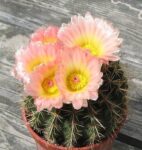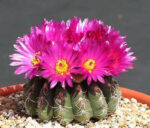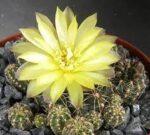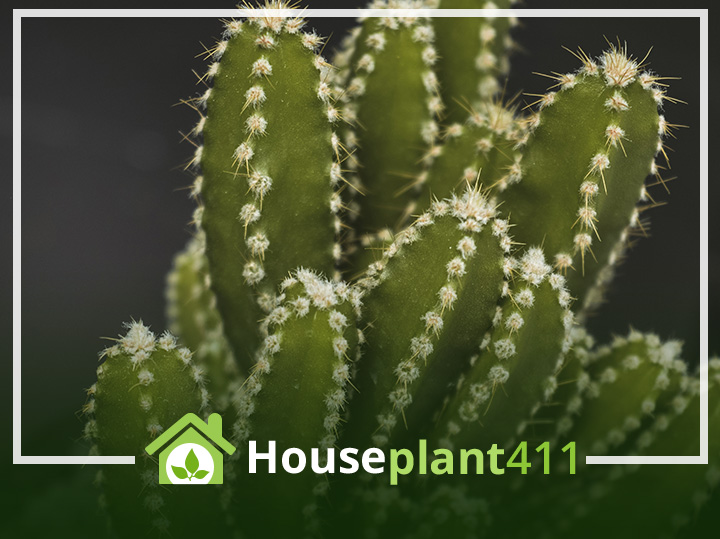About
A cactus plant is an excellent, easy care, indoor or outdoor plant that adapted to very hot, dry, desert areas. Most cacti are succulent plants which means they store water so they can withstand long periods of drought. The leaves of a cactus plant became spines, so it is only the thick, fleshy, stems of the plant store the water. A cactus plant has a waxy skin that also helps the plant retain water. Cacti plants are photosynthetic which means they use sunshine to convert water and carbon dioxide into food. The spines of the plant protect it from birds and other animals and help keep the plant cool by preventing water from escaping. These spines grow out of areoles which are like the leaf nodes found on other plants
Cactus Plant Description
There are about 2000 varieties of cacti, and they come in a wide variety of shapes and sizes. About 50% of indoor cactus plants will bloom is properly cared for. Many produce large, beautiful flowers that can be yellow, white, orange, pink, red, and even blue. Some get flowers that bloom only at night and last just one day while others have flowers that last for weeks. Indoors, a potted cactus plant needs to be three or four years old before it blooms, and flowers only develop on new growth. Keeping a cactus plant slightly rootbound helps it to flower.



Cactus Plant Problems
The base of the cactus becomes soft and mushy when the soil is too wet; this usually occurs in the winter. Although the plant cannot be saved, you can use the healthy upper part for propagation.
Little or no new growth occurs when you don’t give the plant enough water during the warm summer months and give the plant too much water in the cold winter months.
Small, brown, hard, shells on the plant means it has a plant pest called scale. Read how to identify and treat scale in the Glossary of the website.
White, cottony, sticky residue on the leaves is a sign mealy bugs. Read how to identify and treat mealy bugs in the Glossary of the website.
Tips of the stems become soft and shriveled when the plant is over watered.
Quick Care Tips
Average household warmth in the spring, summer, and fall, 10°-20° cooler in winter
Provide good air circulation but do not mist
Place a cactus plant in the sunniest spot in your house
Over watering, especially in winter, is the main reason a cactus plant dies
When repotting, use the next size pot and nothing larger; this helps the soil dry out quickly and prevents root rot.
Conclusion
The spines on a Cactus plant (plural cacti, cactuses) are sharp and dangerous. Though not poisonous, a painful puncture wound from a cactus plant can get infected and cause serious problems for quite some time. Kept cactus plants out of the reach of children, dogs, cats, and other pets. You can read more about common outdoor and indoor plants that can be dangerous in my book Don’t Feed me to Your Cat: A Guide to Poisonous Houseplants.
Plant Care
Light
A cactus plant likes as much bright, indirect light as you can provide. Introduce a cactus plant to direct, morning sunlight gradually to prevent sunburn. The ideal location for a small cactus plant is near a south-facing window.
Water
A cactus plant requires more water in the spring, summer, and early fall when it is growing than in the winter. Allow the soil of a cactus plant to almost dry out before watering during the winter months. Over-watering is the main reason a cactus plant dies.
Fertilizer
Fertilize a cactus plant monthly in the late spring and summer when it is is actively growing. Do not fertilize a cactus plant during the rest of the year. Use a fertilizer low in nitrogen and high in potassium diluted to 1/4 the recommended strength. Tomato plant food works well.
Temperature
An indoor cactus plant likes temperatures between 60°-80°F (15.6°-26.7°C)
Humidity
A cactus plant originated in the desert and does well in very low humidity.
Flowering
After a 3 month resting period and under proper conditions, a cactus plant may bloom during the late fall and winter. Keeping the plant a little root bound helps it to flower. Proper care during the summer encourages new growth. Flowers develop only on the new growth.
Pests
A cactus plant is susceptible to mealy bugs, scale, spider mites, and aphids. Scale is usually found around the spines and can be scrapped off with a child’s toothbrush. Spray the Green Solution (recipe in the Glossary) to get rid of any other pests on a cactus plant. Even plants full of sharp spines get pests!
Diseases
Over-watering a cactus plant leads to crown, stem, and root rot, and is the major reason a cactus plant dies.
Soil
Using a fast-draining, porous, sandy soil helps prevent over-watering a cactus plant. This is the best way to prevent root-rot. You can purchase a special cactus or succulent plant soil at a nursery or make your own.
Pot Size
A vertical cactus plant needs a pot that has a diameter 1/2 the height of the plant. A horizontal cactus plant needs a pot that has a diameter 2″ larger than width of the plant. If a cactus plant starts to topple, plant it in a deeper pot.
Propagation
How to propagate a cactus: Use offsets or stem cuttings in the spring or summer. It is important to let small cuttings dry out for a few days and large cutting for a few weeks before planting them in a peat based soil. You can these propagation methods in the Glossary of the website.
Resting Period
A cactus plant needs less water, drier soil, and cooler temperatures during the winter when it is resting.
Poisonous Plant Info
Although a cactus plant is not a poisonous plant, getting a puncture wound from one of the sharp spines is very unpleasant and could be dangerous if not properly being taken care of.
FAQ
The reason you cactus plant dies, is because you are over watering. A cactus plant is a great indoor plant only if you are careful not to give it too much water! The soil of a cactus plant must be allowed to dry out before you water. In cool weather, a cactus plant can survive on a tablespoon of water per month.
Your cactus plant will love to go outside in warm weather. Be careful to introduce your cactus plant to direct sunlight very gradually or it will get an ugly sunburn. Bring your cactus plant inside before temperatures go below 55°F (12.8°C)
Propagating a cactus plant is quite simple. Break off a small piece from an area on the original cactus plant that’s not easily visible. Dip the cut end of the piece you removed into a small amount of Rooting Hormone. Plant the cactus plant cutting in a small pot of porous, fast-draining soil. A cactus plant is a very slow growing plant so it may take quite some time before you have a substantial new plant.
There are several ways to tell if a cactus plant needs water. When the soil in the pot is wet it holds together, when it’s dry it becomes powdery and falls apart. You can try sticking your finger into the cactus plant pot as far down as you can to test for moisture. You can also stick your finger into the drip holes on the bottom of the pot to check for the moisture around your cactus plant. The easiest way is to simply look at your cactus plant. If the cactus plant has become soft, supple, or even a little shriveled; it is definitely time to water.
A cactus plant, like a gardenia plant, needs temperature fluctuations in order to produce flowers; for a cactus plant, there should be at least a 20°-25° difference between daytime and nighttime temperatures. Feed a cactus plant with a fertilizer low in nitrogen (since it encourages green growth) and high in potassium (since it encourages flowering). Putting a cactus plant outside in the summer encourages the plant to flower, but be careful to avoid direct sun.

